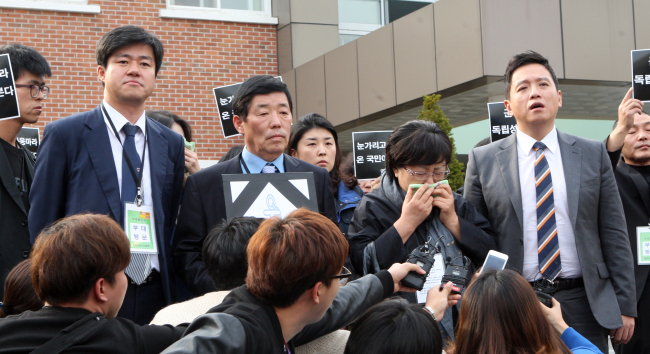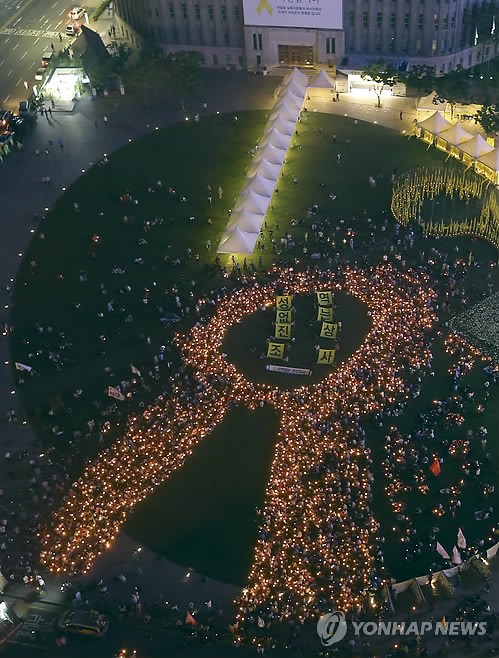A military court Thursday sentenced a 26-year-old sergeant to 45 years in jail on charges of beating a private first class to death, saying that his crime, “close to murder,” deserves a heavy punishment.
The 3rd Army’s court in Yongin, Gyeonggi Province, slapped the five other soldiers, who were accused in the high-profile abuse case, with heavy sentences ranging from 25 years in jail to a suspended jail term of three years.
The case has drawn keen media attention due to public outrage over the death of the victim, identified only by his surname Yun. Yun died on April 7 after suffering physical and mental abuse at his unit of the Army’s 28th Division in Yeoncheon, Gyeonggi Province.
The military prosecution pressed murder charges against three of the accused including the sergeant, but the court cleared them of the charges, saying that the investigative authorities failed to completely prove that the accused had homicidal intent when they assaulted Yun.
The prosecution said that it would appeal the ruling.
Last Friday, the prosecution demanded the death penalty for the sergeant and life imprisonment for three other soldiers.
The prosecution pressed murder charges against three of them rather than the manslaughter charges they initially sought. Prosecutors reversed their position amid rising public criticism over the persistent abuses at Army barracks.
The accused are alleged to have repeatedly beaten Yun because they thought he was too slow in responding to their questions and often grimaced. They also allegedly forced Yun to lick phlegm from the floor and act like a dog, and prevented him from filing a complaint with senior officials.
The prosecution noted that the cause of Yun’s death was “crush syndrome” and “secondary shock.” It initially said that he died after the defendants forced him to swallow dumplings, which caused his airway to be blocked and led to brain damage.
“Crush syndrome” refers to a medical condition in which various organs malfunction as toxic substances that are created due to the damaged muscle tissues enter the bloodstream. Secondary shock results from a massive blood loss.
A series of hazing and abuse cases have triggered public outrage. To shore up public confidence, the military set up a panel to reform the outmoded barracks culture and stamp out abuses, particularly at front-line units.
By Song Sang-ho (sshluck@heraldcorp.com)
The 3rd Army’s court in Yongin, Gyeonggi Province, slapped the five other soldiers, who were accused in the high-profile abuse case, with heavy sentences ranging from 25 years in jail to a suspended jail term of three years.
The case has drawn keen media attention due to public outrage over the death of the victim, identified only by his surname Yun. Yun died on April 7 after suffering physical and mental abuse at his unit of the Army’s 28th Division in Yeoncheon, Gyeonggi Province.
The military prosecution pressed murder charges against three of the accused including the sergeant, but the court cleared them of the charges, saying that the investigative authorities failed to completely prove that the accused had homicidal intent when they assaulted Yun.
 |
| Family members of Pfc Yun hold a news conference after a military court’s verdict on a sergeant who beat him to death. (Yonhap) |
The prosecution said that it would appeal the ruling.
Last Friday, the prosecution demanded the death penalty for the sergeant and life imprisonment for three other soldiers.
The prosecution pressed murder charges against three of them rather than the manslaughter charges they initially sought. Prosecutors reversed their position amid rising public criticism over the persistent abuses at Army barracks.
The accused are alleged to have repeatedly beaten Yun because they thought he was too slow in responding to their questions and often grimaced. They also allegedly forced Yun to lick phlegm from the floor and act like a dog, and prevented him from filing a complaint with senior officials.
The prosecution noted that the cause of Yun’s death was “crush syndrome” and “secondary shock.” It initially said that he died after the defendants forced him to swallow dumplings, which caused his airway to be blocked and led to brain damage.
“Crush syndrome” refers to a medical condition in which various organs malfunction as toxic substances that are created due to the damaged muscle tissues enter the bloodstream. Secondary shock results from a massive blood loss.
A series of hazing and abuse cases have triggered public outrage. To shore up public confidence, the military set up a panel to reform the outmoded barracks culture and stamp out abuses, particularly at front-line units.
By Song Sang-ho (sshluck@heraldcorp.com)
















